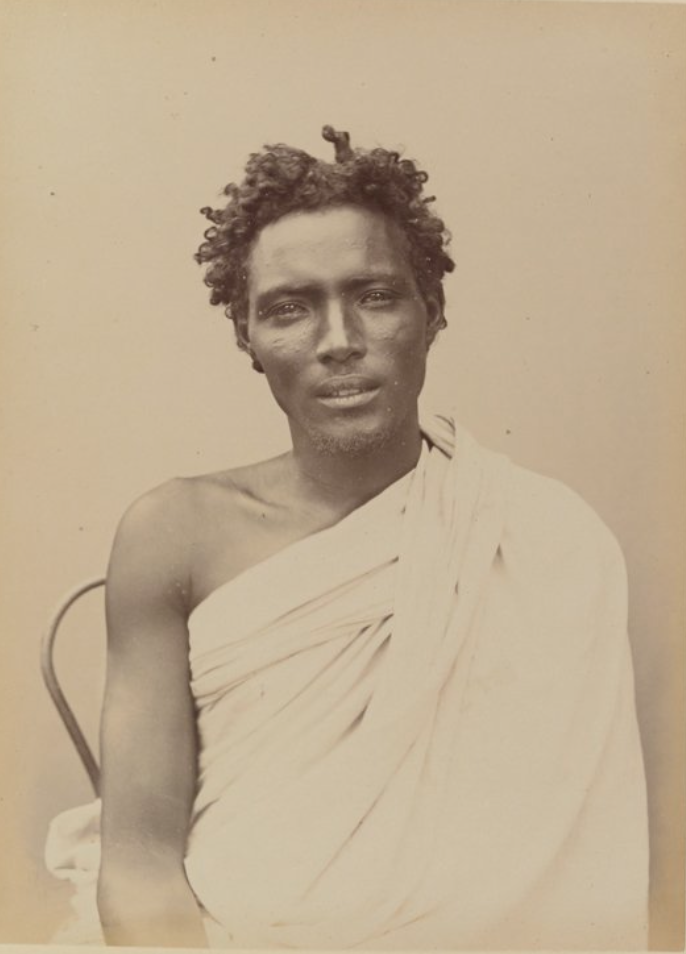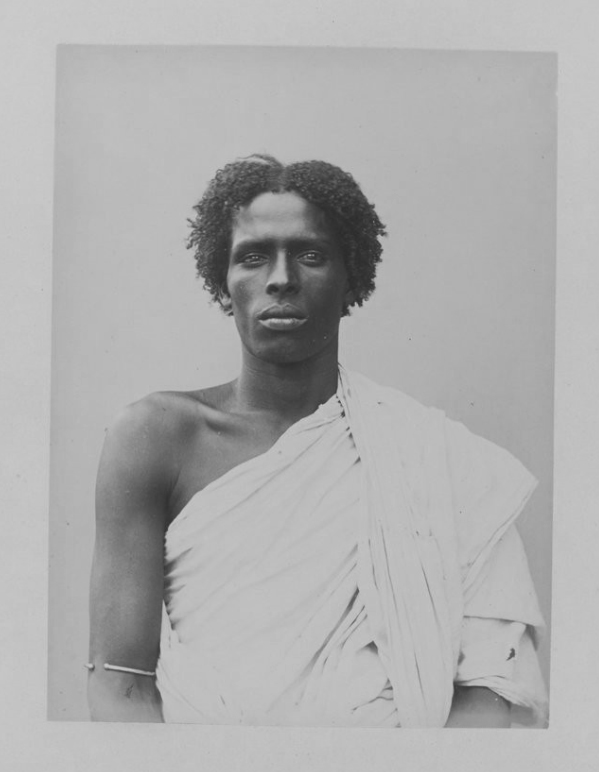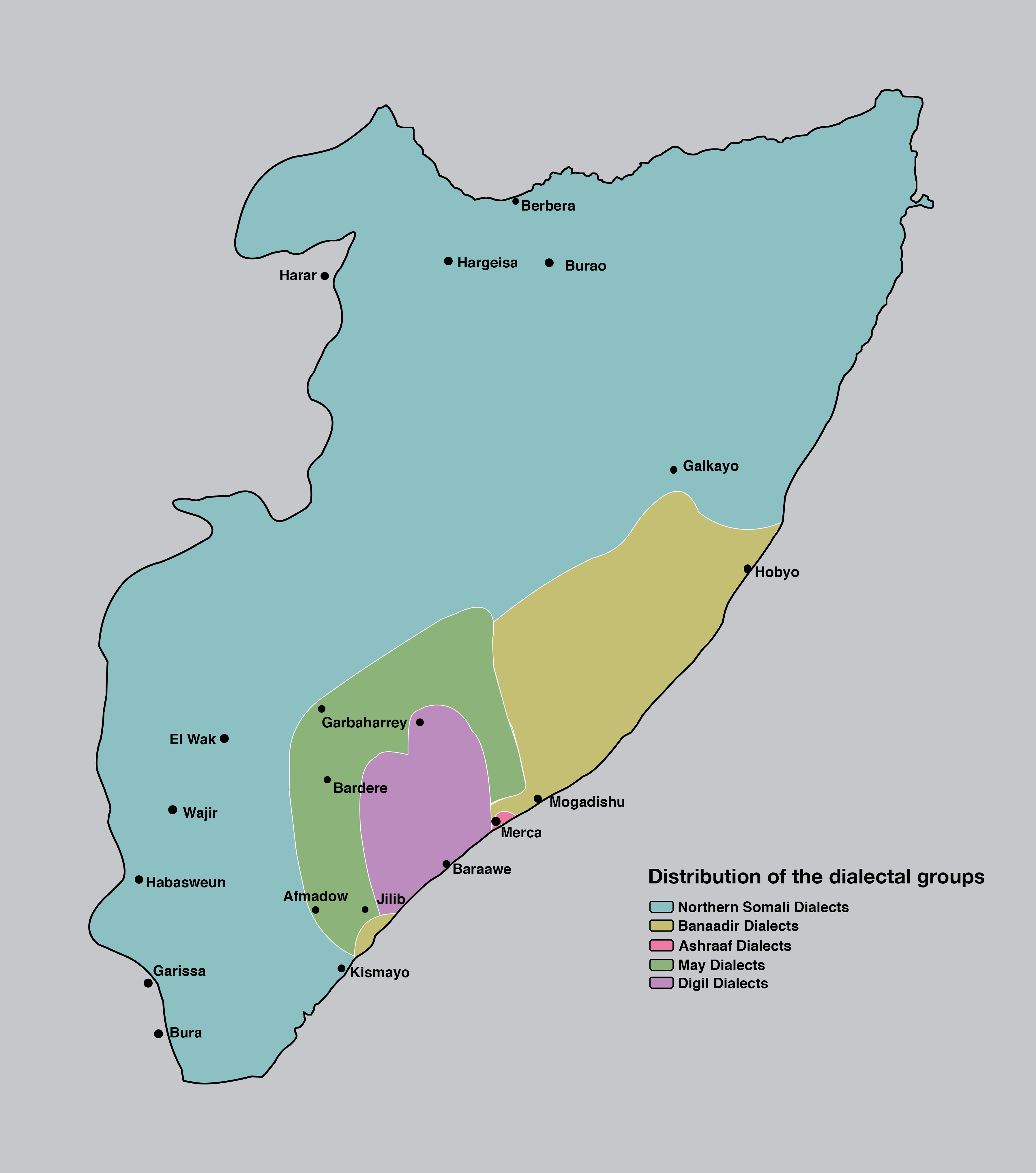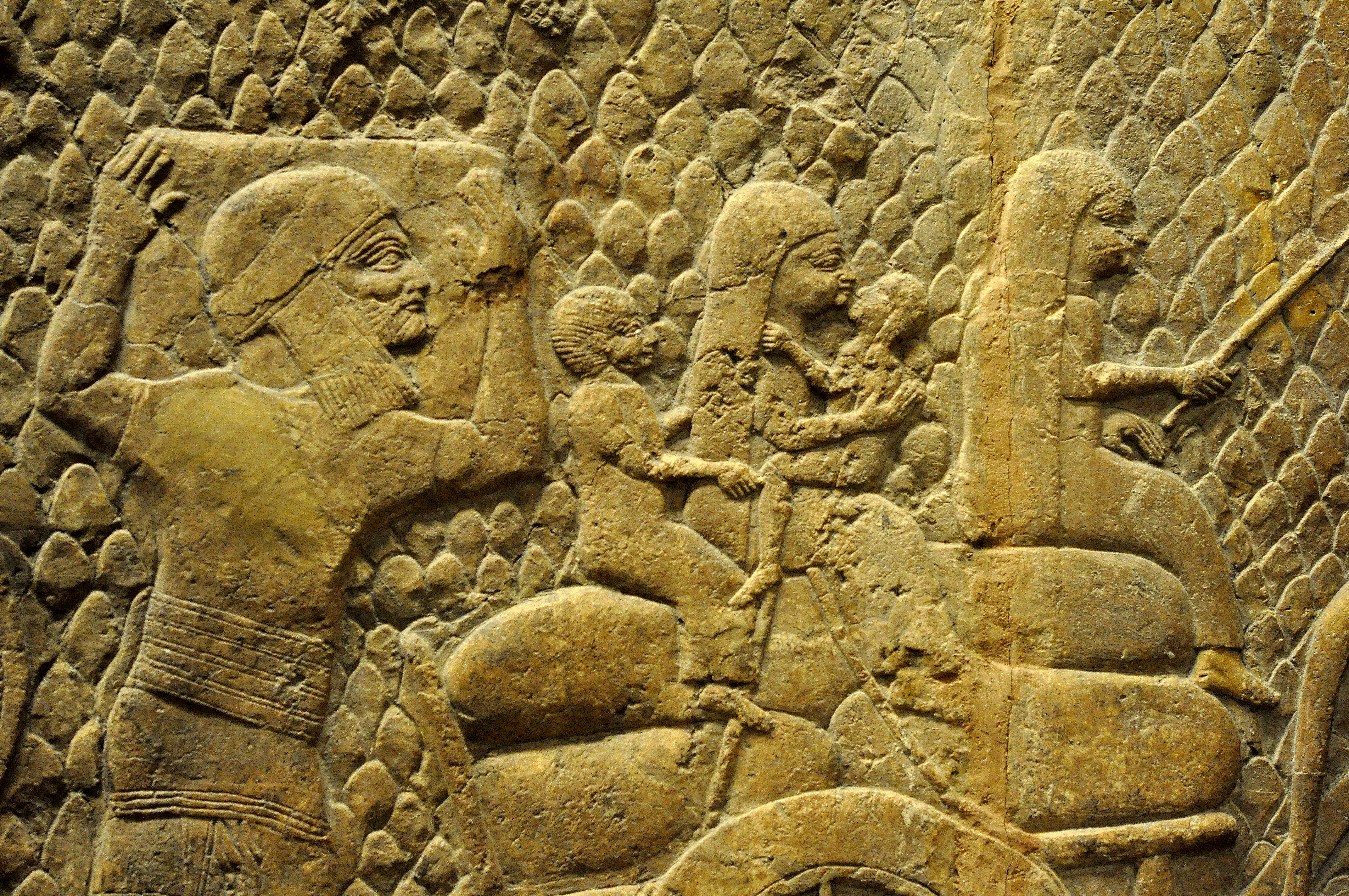|
Yibir
The Yibir, also referred to as the Yibbir, the Yebir, or the Yibro, are a caste of Somali people. They have traditionally been endogamous. Their hereditary occupations have been magic making, leather work, the dispensing of traditional medicine and the making of amulets. They belong to the Sab clan and sometimes referred to as a minority clan, they perform menial tasks. The Somali tradition holds that the Yibir are descendants of Mohammad Hanif of Hargeysa. Mohammad Hanif acquired a reputation as a pagan magician, according to Somali folklore, he was defeated by Yusuf bin Ahmad al-Kawneyn. According to this myth, the rest of the Somali society has ever since paid a small gift to a Yibir after childbirth, as a form of blood compensation. The Yibir have a language (a dialect of Somali) they keep secret from the ruling Somali clans. Although Muslims and ethnically similar to other Somalis, the Yibir caste has been traditionally denigrated, demeaned and discriminated against by ... [...More Info...] [...Related Items...] OR: [Wikipedia] [Google] [Baidu] |
Madhiban
The Madhiban (Somali: Madhibaan, Arabic:مطيبان, also spelled ماديبان, Madeban, Madebaan, or Madebban) alternately known as Reer Sheikh Madhibe or Mohammed Gorgaarte, are a prominent Somali sub-clan of the Gorgaarte, which belongs to the Hawiye conglomerate of clans. They are scattered throughout the Horn of Africa, with the majority residing in the northern part of Somalia (Somaliland and Puntland) and Ethiopia. The Madhibaan traditionally consist of hunters, artisans skilled in ironworking, producers of goods such as weapons, leather products, textiles, and silver ornaments, traditional surgeons and doctors, and farmers. They were also nomadic and engaged in trade. Their influence extends across the Horn of Africa, reflecting their significant impact on Somali society and the broader region's economic and cultural landscape. Etymology The name "Madhibaan" is believed to come from the forefather of the Madhibaan people, Sheikh Madhibe, who was known for his peaceful ... [...More Info...] [...Related Items...] OR: [Wikipedia] [Google] [Baidu] |
Tomal
The Tomal, also known as Tumal or Tumaal, is an artisanal among Somali people. Their traditional hereditary occupation has been as smiths and leather production, and they have been endogamous. The Tomal have been one of the low status castes or outcasts among the Somalis, along with Madhiban and others. They have historically faced discrimination, restrictions, harassment and prejudice from other social strata of the Somali people., Quote: "In addition to the Bantus, there are Somali clans considered to be of low caste and treated as outcasts. They are the Yibir, the Midgan and the Tumal. They face restrictions, prejudice, discrimination, harassment and attacks in East Africa as well as in the Diaspora." Discussion According to the folklore tradition of the Somali people, Tomal and other low castes arose from unholy origins. They were historically smiths who worked various metals, and some also were leather workers (producing and processing animal skin). They may be, states Pete ... [...More Info...] [...Related Items...] OR: [Wikipedia] [Google] [Baidu] |
Somali Languages
The Somali languages form a group that are part of the Afro-Asiatic language family. They are spoken as a mother tongue by ethnic Somalis in Horn of Africa and the Somali diaspora. Even with linguistic differences, Somalis collectively view themselves as speaking dialects of a common language. Some neighboring populations and individuals have also adopted the languages. Somali is for instance used as a second language by speakers of Girirra. Overview Somali variations form a group of East Cushitic languages that are part of the Afroasiatic language family. Their closest relatives are the Aweer and Garre languages, followed by Rendille; this group is sometimes known as Sam or Eastern Omo-Tana. Together with Bayso and the Arboroid languages such as Daasanach, these are known as the Omo-Tana languages. A term "Somaloid" is ambiguous and has been used for either all of Omo-Tana, for the Sam group, or for a group comprising Sam and Baiso. * Afroasiatic ** Semitic languag ... [...More Info...] [...Related Items...] OR: [Wikipedia] [Google] [Baidu] |
Harla
The Harla, also known as Harala, Haralla were an ethnic group that once inhabited Ethiopia, Somalia, and Djibouti. They spoke the Harla language, which belonged to either the Cushitic or Semitic branches of the Afroasiatic family. History The Harla are credited by the present-day inhabitants of parts of Ethiopia, Somalia, and Djibouti with having constructed various historical sites. Although now mostly lying in ruins, these structures include stone necropoleis, store pits, mosques and houses. Cave drawings are also attributed to the Harla. Tradition states one of Harla's main towns was Metehara and the area between Harar and Dire Dawa is still referred to as Harla. The Harla inhabited Chercher and various other areas in the Horn of Africa, where they erected various tumuli. According to historian Richard Wilding, tales indicate Harla lived in the interior of Ogaden and by the seashores prior to Somali and Oromo movements into these regions. The Harla Kingdom existed as e ... [...More Info...] [...Related Items...] OR: [Wikipedia] [Google] [Baidu] |
Yusuf Bin Ahmad Al-Kawneyn
Yusuf bin Ahmad al-Kawneyn () (b. 10th century), popularly known as Aw Barkhadle ("Blessed Father")Abdullahi, p.13 or Yusuf Al Kownayn, was an Islamic scholar and traveler based in Zeila, Somaliland. According to Dr. Enrico Cerulli, Yusuf Al Kawneyn is referenced in the Harar manuscripts. Biography Local Somali oral tradition and written Ethiopian history gives reason to believe Aw Barkhadle arrived from Arabia. However, some scholars hold the opinion that suggests Arabian origin stories pertaining to ancestral saints such as Yusuf, are potentially a myth by scholars and an Islamification of a pre-Islamic origin story that relates back to Waaq and ancestor worship. These myths would tie the Somalis to the prophets clan (Quraysh). Religious synchronism where the old religion is adapted to reflect the hegemony of the new in that the ancestral home of the ancestors in Arabia, the headquarters of Islam. Thus Yusuf has been affirmed to have 'exalted origins' through being related ... [...More Info...] [...Related Items...] OR: [Wikipedia] [Google] [Baidu] |
Somali Language
Somali is an Afroasiatic languages, Afroasiatic language belonging to the Cushitic languages, Cushitic branch, primarily spoken by the Somalis, Somali people, native to Greater Somalia. It is an official language in Somalia, Somaliland, and Ethiopia; one of the two national languages in Djibouti; and a recognised minority language in Kenya. Somali is officially written in the Latin script (Somali Latin alphabet), with the Arabic script (Wadaad's writing) and several local scripts (Osmanya script, Osmanya, Kaddare script, Kaddare and Gadabuursi Somali Script, Borama scripts) being informally used.Lewis, I.M. (1958)The Gadabuursi Somali Script ''Bulletin of the School of Oriental and African Studies'', University of London, Vol. 21, pp. 134–156. Classification Somali is classified within the Cushitic branch of the Afroasiatic family, specifically, Lowland East Cushitic languages, Lowland East Cushitic in addition to Afar language, Afar and Saho language, Saho. Somali is the bes ... [...More Info...] [...Related Items...] OR: [Wikipedia] [Google] [Baidu] |
Hebrews
The Hebrews (; ) were an ancient Semitic-speaking peoples, ancient Semitic-speaking people. Historians mostly consider the Hebrews as synonymous with the Israelites, with the term "Hebrew" denoting an Israelite from the nomadic era, which preceded the establishment of the Kingdom of Israel (united monarchy), Kingdom of Israel and Judah in the 11th century BCE. However, in some instances, the designation "Hebrew" may also be used historically in a wider sense, referring to the Phoenicians or other ancient Semitic-speaking civilizations, such as the Shasu on the eve of the Late Bronze Age collapse. It appears 34 times within 32 verses of the Hebrew Bible. Some scholars regard "Hebrews" as an ethnonym, while others do not, and others still hold that the multiple modern connotations of Ethnicity#Definitions and conceptual history , ethnicity may not all map well onto the sociology of Ancient Near East, ancient Near Eastern groups. By the time of the Roman Empire, the term () coul ... [...More Info...] [...Related Items...] OR: [Wikipedia] [Google] [Baidu] |
Horn Of Africa
The Horn of Africa (HoA), also known as the Somali Peninsula, is a large peninsula and geopolitical region in East Africa.Robert Stock, ''Africa South of the Sahara, Second Edition: A Geographical Interpretation'', (The Guilford Press; 2004), p. 26 Located on the easternmost part of the African mainland, it is the fourth largest peninsula in the world. It is composed of Somaliland, Somalia, Djibouti, Ethiopia, and Eritrea. Although not common, broader definitions include parts or all of Kenya and Sudan.John I. Saeed, ''Somali'' – Volume 10 of London Oriental and African language library, (J. Benjamins: 1999), p. 250.Sandra Fullerton Joireman, ''Institutional Change in the Horn of Africa'', (Universal-Publishers: 1997), p.1: "The Horn of Africa encompasses the countries of Ethiopia, Eritrea, Djibouti, and Somalia. These countries share similar peoples, languages, and geographical endowments." It has been described as a region of geopolitical and strategic importance, since it ... [...More Info...] [...Related Items...] OR: [Wikipedia] [Google] [Baidu] |
Roger Blench
Roger Marsh Blench (born August 1, 1953) is a British linguist, ethnomusicologist and development anthropologist. He has an M.A. and a Ph.D. from the University of Cambridge and is based in Cambridge, England. He researches, publishes, and works as a consultant. Career Blench is known for his wide-ranging interests and has made important contributions to African linguistics, Southeast Asian linguistics, anthropology, ethnomusicology, ethnobotany, and various other related fields. He has done significant research on the Niger–Congo, Nilo-Saharan, and Afroasiatic families, as well as the Arunachal languages. Additionally, Blench has published extensively on the relationship between linguistics and archaeology. Blench is currently engaged in a long-term project to document the languages of central Nigeria. He has also expressed concern about ranching in Nigeria. Blench collaborated with the late Professor Kay Williamson, who died in January 2005, and is now a trustee of the ... [...More Info...] [...Related Items...] OR: [Wikipedia] [Google] [Baidu] |
British Army
The British Army is the principal Army, land warfare force of the United Kingdom. the British Army comprises 73,847 regular full-time personnel, 4,127 Brigade of Gurkhas, Gurkhas, 25,742 Army Reserve (United Kingdom), volunteer reserve personnel and 4,697 "other personnel", for a total of 108,413. The British Army traces back to 1707 and the Acts of Union 1707, formation of the united Kingdom of Great Britain which joined the Kingdoms of Kingdom of England, England and Kingdom of Scotland, Scotland into a Political union, single state and, with that, united the English Army and the Scots Army as the British Army. The Parliament of England, English Bill of Rights 1689 and Convention of the Estates, Scottish Claim of Right Act 1689 require parliamentary consent for the Crown to maintain a peacetime standing army. Members of the British Army swear allegiance to the Charles III, monarch as their commander-in-chief. The army is administered by the Ministry of Defence (United Kingd ... [...More Info...] [...Related Items...] OR: [Wikipedia] [Google] [Baidu] |
Enrico Cerulli
Enrico Cerulli (15 February 1898 – 19 August 1988) ''Worldcat''. Retrieved 27 Oct 2024. was an scholar of Somali and Ethiopian studies, a and a . Biography Cerulli was born in |
Dialect
A dialect is a Variety (linguistics), variety of language spoken by a particular group of people. This may include dominant and standard language, standardized varieties as well as Vernacular language, vernacular, unwritten, or non-standardized varieties, such as those used in developing countries or isolated areas. The non-standard dialects of a language with a writing system will operate at different degrees of distance from the standardized written form. Standard and nonstandard dialects A ''standard dialect'', also known as a "standardized language", is supported by institutions. Such institutional support may include any or all of the following: government recognition or designation; formal presentation in schooling as the "correct" form of a language; informal monitoring of everyday Usage (language), usage; published grammars, dictionaries, and textbooks that set forth a normative spoken and written form; and an extensive formal literature (be it prose, poetry, non-ficti ... [...More Info...] [...Related Items...] OR: [Wikipedia] [Google] [Baidu] |







